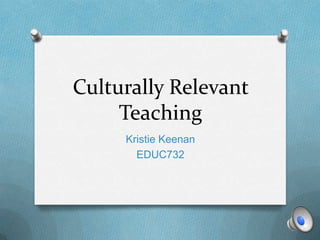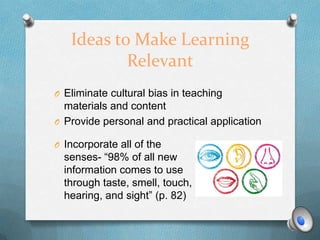Culturally Relevant Teaching
- 3. The 3 RŌĆÖs of Education ORelationships ORelevance ORigor
- 5. Relationships O Get to know your students and their culture so that you can better meet their needs O ŌĆ£We are all learners togetherŌĆō including the teacher. It is not the curriculum and the teacher against the student; it is the teacher and student together tackling the curriculum, and together they will be successfulŌĆØ (Tileston & Darling, p.102).
- 6. Ideas to Build Relationships O ŌĆ£I am From PoemsŌĆØ, ŌĆ£Me ChartsŌĆØ, etc. O Get to know Student Learning Styles O Perceptual Style O Attentional Style O Conceptual Style O Thinking Style O Talk to students about their perspectives, ideas, and goals O Let students know you believe in them through encouragement and praise
- 8. Relevance O Making learning meaningful and teaching for relevance is critical O Our brains discard 99% of incoming informationŌĆ” So how do we make it stick? O ŌĆ£Making content relevant has the potential to increase student performance by as much as 40 percentile pointsŌĆØ (Tileston & Darling, p.80).
- 9. Ideas to Make Learning Relevant O Eliminate cultural bias in teaching materials and content O Provide personal and practical application O Incorporate all of the senses- ŌĆ£98% of all new information comes to use through taste, smell, touch, hearing, and sightŌĆØ (p. 82)
- 10. Ideas to Make Learning Relevant Cont. O Facilitate ŌĆ£contextual learningŌĆØ experiences- constructivist learning, real-life problem solving, authentic assessments, etc. O Incorporate All Multiple Intelligences O Styles and preferences vary from one ethnic group to another O Activate Prior Knowledge O ŌĆ£Our students are more likely to ŌĆ×get itŌƤ from the beginning if we can find ways to either tap into prior learning orŌĆ”create themŌĆØ (p.92)
- 12. Rigor O ŌĆ£The best learning state is one in which students are moderately challenged, so that they remain motivated. We do not want the challenge to be impossible; we want it to be incrementalŌĆØ (p.97). O Zone of Proximal Development
- 13. Ideas to Provide Rigor O Help Build self-efficacy O ŌĆ£I know I can do this because I have been successful before.ŌĆØ O Scaffold studentsŌƤ learning O ŌĆ£We create a way for students to gain the understanding needed to venture to higher learningŌĆØ (p.98) O Stimulate In-Depth Thinking O Wiggins & McTigheŌƤs 6 levels of understanding
- 15. References O Gay, G. (2010). Culturally responsive teaching: Theory, research and practice. New York, NY: Teachers College Press. O Tileston, D., Darling, S. (2008). Why culture counts: Teaching children of poverty. Bloomington, IN: Solution Tree Press. O Wolfe, P. (2010). Brain matters: Translating research into classroom practice. (2nd ed.). Alexandria, VA: ASCD.















